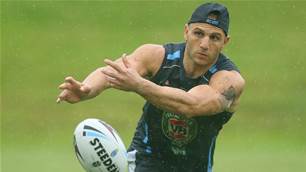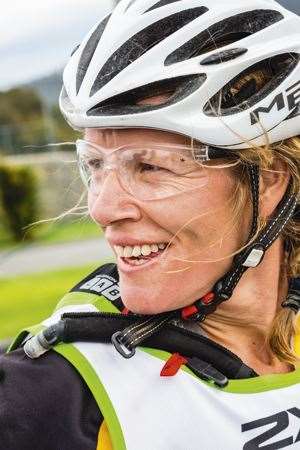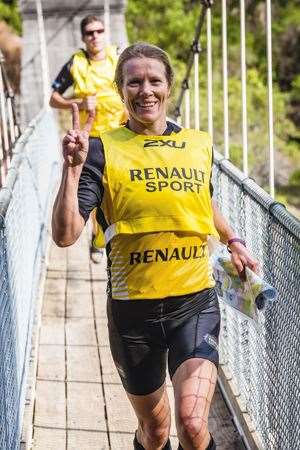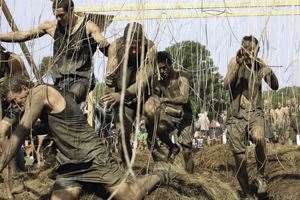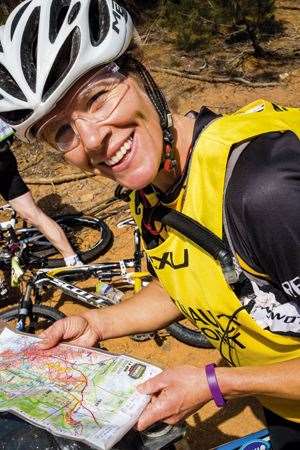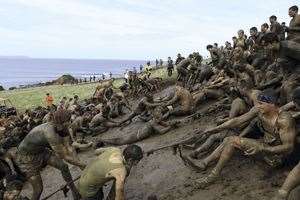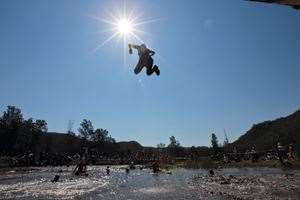The irony of Commonwealth Games and World Championship triathlete Deanna Blegg tackling Tough Mudder events is difficult to miss.
The irony of Commonwealth Games and World Championship triathlete Deanna Blegg tackling Tough Mudder events is difficult to miss. The electrified, steep-walled and muddied obstacles of this travelling torture circus are symbolic of the challenges Blegg has faced on her life’s journey to hell and back. “There’s a lot of synergy there and probably why I’m so passionate about this type of sport,” she offers. “Life is about overcoming obstacles – whether you go over them, through them or under them – and achieving something at the end.”
For the uninitiated, Tough Mudder is a hardcore 18-20km obstacle course designed by British Special Forces to test contestants’ all-round strength, stamina, mental grit and camaraderie. That Blegg finds these events “fun” becomes understandable after you’ve heard of her life of fighting – and living with – the HIV virus.
Blegg’s years of adventure/obstacle-course racing provide a concrete-solid base for events like Tough Mudder. At 17, she was crowned junior world triathlon champion and became the tenth-ranked woman on the planet, so it was only a matter of time before this now-Victorian resident caught up to the pack, despite the debilitating effects of her illness. These days she’s settled into a groove of attacking long-distance events, like the gruelling Mark Webber Challenge in Tassie.
While Blegg will be an absentee from the upcoming Sydney Tough Mudder, scheduled for October 12–13 near Penrith, she has a good excuse. She’ll soon be jetting off to New Jersey to attack the 24-hour version, World’s Toughest Mudder, set down for November 16-17. (The world’s most eager entrants found out just how tough Blegg is when she finished third from about 1300 female and male competitors at last year’s event.)
If you’re thinking about tackling a Tough Mudder, read Blegg’s advice carefully. If there’s a fitter (or tougher) 44-year-old female athlete in Australia, we’d love to meet her ...
FITNESS FIRST
“I was an athlete when I was young, then I had close to 15 years off, not really doing anything, before firing my personal fitness back up in 2007. I had a bit of a rocky road in between. From the age of about 30, I started concentrating on my fitness, but with no real goals, nothing in place. I’d just go for a run or go to the gym, that sort of thing. In 2005, I saw a promo for an adventure race. That’s when I thought, ‘I’m going to do this.’
“I just wanted a goal. I was working as a personal trainer at the time, helping people achieving theirs, and I thought, ‘Hey, what’s my goal?’ I think my main motivator was that I’d assisted a lady who’d lost about 60kg and had run a marathon. I was a big part of that journey; I ran the marathon side-by-side with her. When she finished, to feel her elation and the spirit she felt for having accomplished something was amazing. I thought, ‘Hey, I need some of that for me ... ”
TOUGH START
“I’ve completed two Tough Mudders in Australia and one in the States. I’ve done lots of obstacle races, too, slightly different to Tough Mudders. As soon as I found out about the Tough Mudder concept, I saw, too, that they ran a World’s Toughest Mudder. That quickly became my focus. So I did the one here in Melbourne to qualify, and went across to the States last year.
“In the lead-up to my first event in Australia, I was well into adventure racing; I was even used to racing five days back-to-back. They advertise it as the toughest thing you’ll ever do ... true, depending on who you are. If you’re going flat-out, it’s going to be hard-yakka. I found that, while the obstacles weren’t necessarily tough, they were challenging; they challenge your body in different ways. I liked that. I was aware of my weaknesses and where I had to become stronger. You had to finish in the top five percent to qualify for the US event, but I had no idea what that looked like. For me, my first time was about getting the course done as quickly as I could so I could get across to the States, which was my ultimate goal.”
GROUP THING
“People thinking about entering a Tough Mudder should know that it is achievable. It’s not just you out there on the course, but many others, too. I recommend doing your first event with a group of people, which really } adds to the fun of it all. I’d get a group of people together of similar fitness capabilities. There are training programs online which could help you prepare. Boot camps are great – join one of those ... And start running. Not fast, not hard, just learn to run; there’s a lot of that involved.”
FIT AND READY
“Any exercises which require you to lift and move your body a bit differently to the way you normally do will make for an ideal preparation; your standard gym isn’t a great help because you’re stagnant and isolating muscles. You need to be doing exerises where you’re picking up and throwing things, challenging your body in much more realistic ways. Climbing as well ... climbing cargos. Literally hanging out in parks is good, where there’s monkey bars, etc. I went to the park quite a bit and climbed and jumped over things, crawled under stuff.”
FACING OBSTACLES
“There’s a lot of water and mud involved in Tough Mudder. Some of the most challenging obstacles I’ve seen are the climbing things, like cargo nets, and the ones where competitors jump into water from a height of three or four metres after climbing up onto a platform. A lot of people get stuck there because of fear. It’s beautiful watching people conquer those fears. To see someone sit there for ten minutes, then finally get the courage to jump, and seeing the elation when they come out ... When I finish, I go back and watch other people completing the obstacles. It’s beautiful. There’s a few dark tunnels you have to go through, too. For me, it’s okay, but for someone who struggles with confined spaces, it’s really confronting.”
NO LOSERS
“I think I’m passionate about adventure and obstacle racing so much because it’s the only type of racing where I’ve noticed really strong fields of women as well as men. A lot of events scare women off, but women are attracted to Tough Mudder. Being a woman in sport, you go to an event and you think, ‘Where are
all the women?’ But you turn up to one of these events and there’s teams of women; there’s women dressed up in fancy dress and everyone’s smiling.
“Because it’s not a timed event, people see it as being achievable. Competitors start in waves. If you do a fun run, there’s a start, and you finish, and if you’re not very fast, you finish at the back end, or last, and people feel that. Whereas in one of these events, every ten minutes there’s a couple of hundred people starting, so you never feel alone out there. Everyone’s helping everyone getting over and through obstacles; it turns an individual event into a team sport.”
ELECTRIC EEL
“I’m not going to sell this very well, but my least-favourite obstacle is the ‘Electric Eel’. I didn’t really have a problem with it in my first Aussie Tough Mudder, but the following year, it really got me. My gosh. The zap was like BANG. You’re in water, you’re crawling along, and there’s all these electric wires hanging down. Every time they hit you, you get an electric shock. On this occasion they seemed incredibly charged – and I got stuck in it. Every time the wind blew, the wires would hit me ... zap! It was getting me on the head, arms, everywhere. I was wondering whether to go through slowly and get zapped slowly, or go fast, where you might splash up water, which makes the zaps even bigger. Anyway, I got out of there and felt like I’d been pulverised.”
FUELLING UP
“I’m not a carb-loader for an event; I normally fuel through an event. What do I have for breakfast? Normally just rice, honey, with a little bit of butter on it, and salt. That’s my thing – I’m gluten-intolerant. Honey’s great. I’ve been on it for many, many years. My body doesn’t tolerate gels, so I had to find another liquid substitute that my body could handle. Honey’s full of natural energies. It’s very simple. I mix it with a bit of water. It’s made from nature. It hasn’t been interfered with by humans. I’m a pro-natural girl.”
HIV AND ME
“Because I’ve lived for 20 years with it, who knows what my athletic capabilities would be without it? I was infected at 23, diagnosed at 24 years old. The first five years were of sickness and ill-health, and then it was more of a focus on getting my life back together, believing that I was going to live, and creating a life. I was also told I couldn’t exercise; I wasn’t allowed to do much. But the older I got, the more I thought, ‘Nah, I’m not going to sacrifice my likes; I want to find out what I’m capable of.’ That’s when I started pushing my body bit by bit and seeing what happened.”
− James Smith
Related Articles
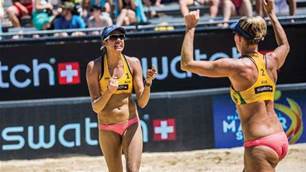
How Australia's beach volleyball women train

How Australia's beach volleyball women train
